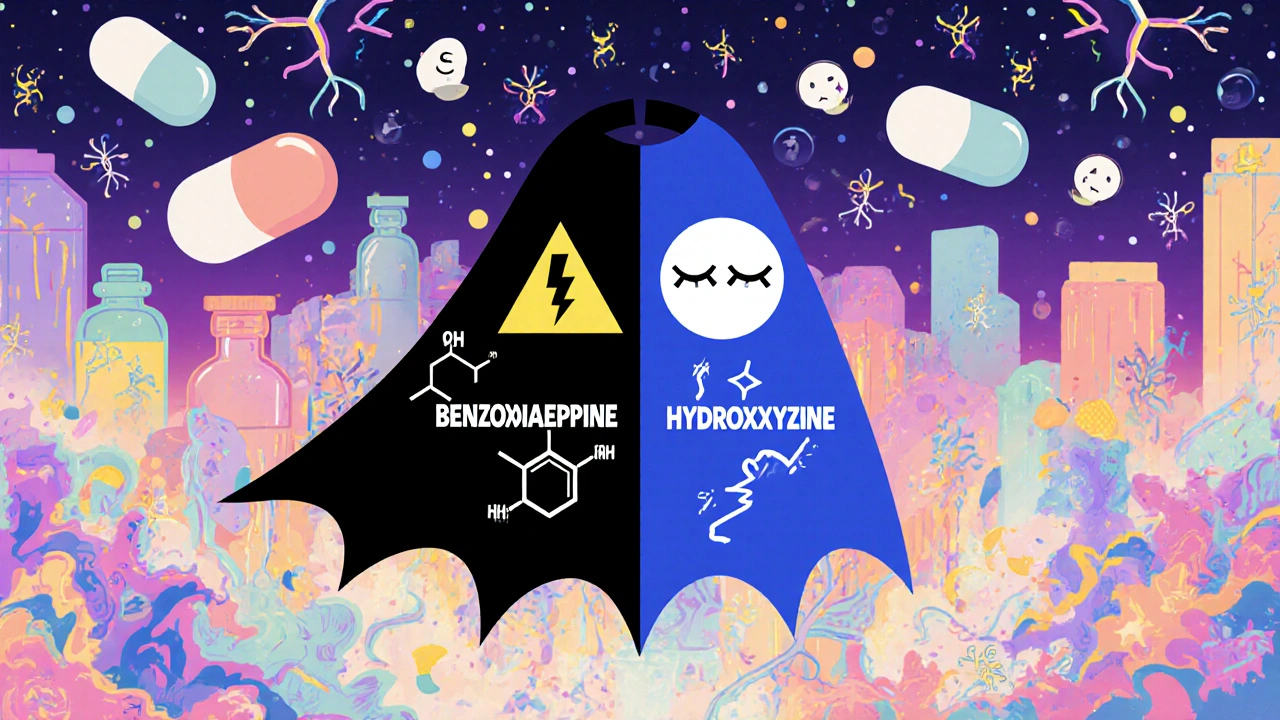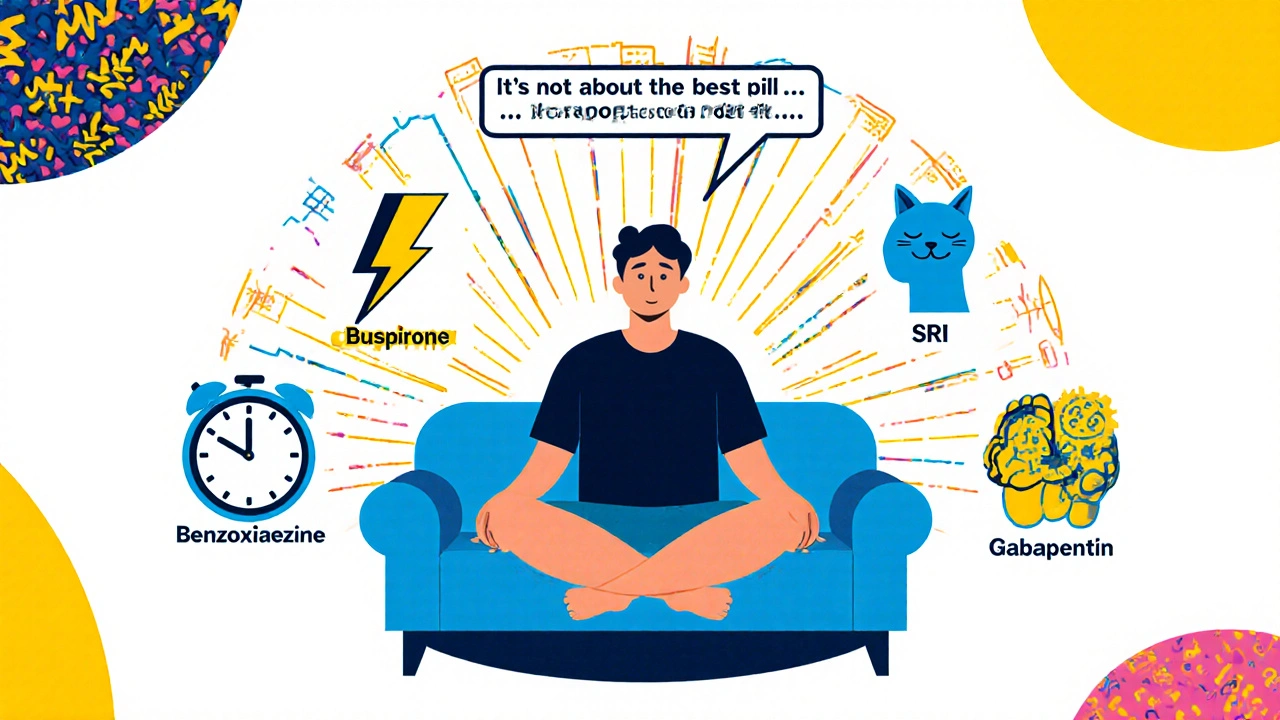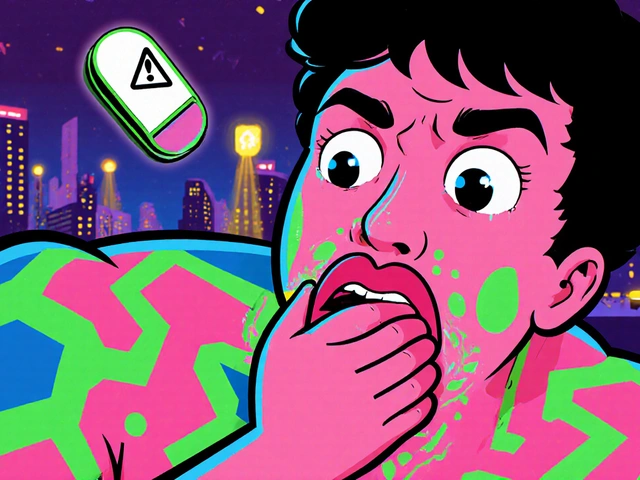If you’ve been prescribed Buspar (buspirone) for anxiety, you’re not alone. But maybe it’s not working quite right-maybe the side effects are getting to you, or it just doesn’t seem to help enough. You start wondering: Are there better options? The truth is, buspirone isn’t the only tool in the box for managing anxiety. There are other medications, each with different pros, cons, and how they work in your body. Let’s cut through the noise and compare buspirone to real alternatives you might actually consider.
What Buspar (Buspirone) Actually Does
Buspirone, sold as Buspar, is an anti-anxiety drug that works differently from most others. It doesn’t touch GABA receptors like benzodiazepines (Xanax, Valium) do. Instead, it targets serotonin 5-HT1A receptors. This makes it non-addictive and less likely to cause drowsiness or memory issues. But that also means it doesn’t work fast. Most people don’t feel relief until after 2-4 weeks, sometimes up to 6. That’s a long wait when you’re struggling with daily panic or constant worry.
It’s not a sedative. It won’t knock you out. It’s not meant for acute panic attacks. It’s designed for generalized anxiety-those persistent, low-grade worries that hang around all day. People who’ve tried it often say it takes the edge off without making them feel numb. But if you need quick relief, buspirone won’t cut it.
Alternative 1: SSRIs (Sertraline, Escitalopram)
SSRIs like sertraline (Zoloft) and escitalopram (Lexapro) are the first-line treatment for anxiety in most clinical guidelines. Unlike buspirone, they take 4-8 weeks to kick in, but they’re proven to work better for most people over time. They’re also approved for both anxiety and depression, which matters if you’re dealing with both.
Side effects? Yes-nausea, sexual dysfunction, insomnia, weight gain. But many people tolerate them fine after the first few weeks. A 2023 meta-analysis in the Journal of Clinical Psychiatry found SSRIs had a 58% response rate for generalized anxiety disorder, compared to buspirone’s 42%. That’s a meaningful difference.
If you’ve tried buspirone and it didn’t help, your doctor might switch you to an SSRI. It’s not a guarantee, but it’s the most common next step.
Alternative 2: SNRIs (Venlafaxine, Duloxetine)
SNRIs like venlafaxine (Effexor) and duloxetine (Cymbalta) work on both serotonin and norepinephrine. They’re often used when SSRIs don’t work well enough-or when anxiety comes with physical symptoms like muscle tension or chronic pain.
Duloxetine, for example, is FDA-approved for both anxiety and fibromyalgia. If you’ve got both, it’s a two-for-one. But SNRIs can raise blood pressure and cause more withdrawal symptoms than SSRIs. Stopping them cold turkey can lead to brain zaps, dizziness, or flu-like symptoms. That’s why tapering is critical.
Compared to buspirone, SNRIs have stronger evidence for long-term anxiety control. But they’re not first-choice for everyone because of their side effect profile. They’re often reserved for cases where simpler options fail.
Alternative 3: Benzodiazepines (Lorazepam, Clonazepam)
Benzodiazepines like lorazepam (Ativan) and clonazepam (Klonopin) work fast-within 30 to 60 minutes. That’s why they’re still used for acute panic attacks or short-term anxiety spikes. But here’s the catch: they’re addictive. Even using them for 3-4 weeks can lead to dependence. Withdrawal can be dangerous, with seizures possible in severe cases.
Doctors rarely prescribe them long-term. In Australia, they’re classified as Schedule 4 controlled substances. Many psychiatrists now avoid them unless other treatments have failed. If you’re on buspirone and still having panic attacks, a short-term benzodiazepine might be added temporarily-but never as a replacement.
Buspirone wins here on safety. Benzodiazepines win on speed. You can’t have both.

Alternative 4: Hydroxyzine
Hydroxyzine (Vistaril) is an antihistamine that’s been used off-label for anxiety for decades. It’s not a controlled substance, doesn’t cause dependence, and works within an hour. It’s often used in patients who can’t take SSRIs due to side effects, or in pregnant women (it’s Category C, so use with caution).
The downside? It makes you drowsy. A lot. People report feeling like they’ve had a few drinks-slowed thinking, dry mouth, fatigue. It’s not ideal for daytime use if you’re driving or working. But for nighttime anxiety or situational stress (like flying or medical procedures), it’s a solid option.
Compared to buspirone, hydroxyzine is faster and more sedating. It’s a good bridge if you need immediate relief while waiting for an SSRI to kick in.
Alternative 5: Pregabalin and Gabapentin
These are anti-seizure drugs that also calm overactive nerves. Pregabalin (Lyrica) is approved for generalized anxiety disorder in Europe and some other countries, but not in the U.S. or Australia for anxiety alone. Gabapentin (Neurontin) is used off-label all the time.
They work within a few days, aren’t addictive like benzodiazepines, and help with both anxiety and nerve pain. Side effects include dizziness, weight gain, and brain fog. Some people love them. Others feel too spaced out.
They’re a middle ground: faster than buspirone, less risky than benzos. But evidence is mixed. A 2024 review in Annals of Clinical Psychiatry found gabapentin had moderate effectiveness, but high dropout rates due to side effects.
How to Decide What’s Right for You
There’s no one-size-fits-all. Here’s how to think about it:
- Need fast relief? Try hydroxyzine or a short-term benzo (only under supervision).
- Want long-term, non-addictive control? SSRIs or SNRIs are your best bet.
- Have physical pain along with anxiety? Duloxetine or pregabalin might help both.
- Can’t tolerate SSRIs? Buspirone or hydroxyzine are safer fallbacks.
- Worried about addiction? Avoid benzos. Stick with buspirone, SSRIs, or hydroxyzine.
Buspirone isn’t a bad drug. It’s just not for everyone. It’s best for people who want to avoid sedation and dependency. If you’re still anxious after 6 weeks on it, it’s time to talk about switching.

What Doesn’t Work as an Alternative
Some people try natural remedies-valerian root, CBD, kava. CBD has some promising early data, but it’s not regulated, and quality varies wildly. Kava has liver toxicity warnings in Australia and the EU. Valerian? Might help sleep, but not anxiety.
Therapy-CBT, mindfulness, exposure therapy-is the only non-drug option with evidence matching or beating medication. If you’re not doing therapy, you’re missing half the picture. Medication helps manage symptoms. Therapy helps change the thinking patterns that cause them.
Final Thought: It’s Not About Finding the ‘Best’ Drug
It’s about finding the right fit for your body, your life, and your goals. Buspirone is gentle, safe, and slow. SSRIs are more effective but come with more side effects. Benzodiazepines are fast but risky. Hydroxyzine is a quiet helper for occasional use.
Don’t give up if one doesn’t work. Try another. Track your symptoms. Talk to your doctor about what you’re feeling-not just ‘I’m anxious,’ but ‘I’m anxious at 3 p.m. when I’m alone,’ or ‘I can’t sleep because my mind races.’ Specifics help them choose better.
There’s no magic pill. But there are options. And you deserve to find one that lets you breathe again.
Is Buspar better than Xanax for anxiety?
No, Buspar isn’t better than Xanax for immediate relief-Xanax works in minutes, Buspar takes weeks. But Buspar is far safer long-term. Xanax is addictive and can cause withdrawal seizures. Buspar isn’t addictive and has no withdrawal risks. If you need quick panic control, Xanax helps. If you want daily anxiety management without dependency, Buspar is better.
Can you take Buspar and an SSRI together?
Yes, but only under close medical supervision. Combining Buspar with an SSRI can increase serotonin levels too much, leading to serotonin syndrome-a rare but dangerous condition with symptoms like rapid heart rate, high fever, confusion, and muscle rigidity. Doctors usually avoid this combo unless someone has partial response to an SSRI alone and needs a boost.
Why does Buspar take so long to work?
Buspar doesn’t act on fast-acting brain chemicals like GABA. Instead, it slowly adjusts serotonin receptor sensitivity over weeks. Think of it like retraining your brain’s response to stress, not silencing it. That’s why it takes time-your nervous system needs to adapt. It’s not broken; it’s just slower than other drugs.
Is there a generic version of Buspar?
Yes. Buspar is the brand name. The generic is buspirone, and it’s widely available and much cheaper. There’s no difference in effectiveness between the brand and generic. Many people switch to generic to save money-especially if they’re on long-term treatment.
What’s the most common mistake people make with Buspar?
Stopping it too soon. People expect it to work like Xanax and quit after a week or two because they don’t feel better. But it takes 2-6 weeks. The biggest mistake isn’t side effects-it’s giving up before it has a chance. Stick with it, track your mood daily, and talk to your doctor at the 4-week mark.
Next Steps: What to Do Now
- If you’re on Buspar and it’s not working after 6 weeks, schedule a review with your doctor. Don’t wait.
- If you’re on a benzo and want to get off, ask about switching to an SSRI or buspirone-don’t quit cold turkey.
- If you’re not in therapy, consider starting. Even 8-12 sessions of CBT can make more difference than any pill.
- Keep a simple journal: rate your anxiety (1-10) and note what happened that day. Patterns help your doctor choose better.
Anxiety treatment isn’t a race. It’s a process of trial, feedback, and adjustment. You’re not failing if one drug doesn’t work. You’re just gathering data. And every step brings you closer to feeling like yourself again.


